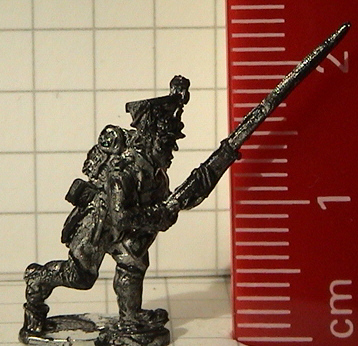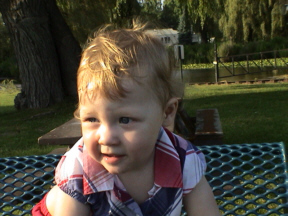|
|
||||||||||||||||||
 |
||||||||||||||||||
 |
|
How Real is Real? You’ve seen the claim before - these miniatures are painted extremely realistically. The faces are shadowed, the eyes are painted, the uniforms are correct to the last piece of piping. Perhaps it was in an item description on Ebay. Maybe it was on a painting service’s web site. The question is, what does such a claim mean? I want to raise a few points on the subject in regard specifically to the 15 mm scale, but the same issues apply at all scales. My main point is that this hobby has adopted the language of Realism when what we do is, in fact, most analogous to impressionism. When we speak about realism in any scale, there are a number of dimensions along which a miniature may be said to be realistic. First, the casting itself must be realistic. That is, the body and equipment need to be in proportion to each other. The pose and expression of the figure need to be recognizably human, as well as appropriate to the milieu if the represented figure. A charging grenadier, for example, may have a facial expression of shouting rage that would probably look like a sneeze on a fusilier standing at attention. There is an interesting discussion on this point at the Miniatures Page (addressing the lack of anatomical accuracy in miniatures). Second, the paint job needs to be accurate as regards uniform and equipment details. Shield details, cuffs, and piping need to all be in the correct colors and in the correct places. Third, the effects of light - shadowing and highlighting - need to be captured in the paint job. This is accomplished in many ways - by blending, dry brushing, using washes, and even using a “miracle dip” that shadows an entire figure in one fell swoop. Is That Piping in Your Pocket Or Are You Just Glad to See Me? In considering the realism of the sculpt, most attention is paid to the details of the uniform and equipment. Is the backpack the right size? Does the cuff have the right number of buttons? Generally, in this hobby, the more details of this nature that are present the more “realistic” a mini is judged to be. But is this truly realistic? Notice first of all the cord on the rear side of the shako. It is, perhaps, one quarter of a millimeter in diameter. At a scale of 1:100 that would assume the actual cord was 25 mm (about 1”) in diameter. A very heavy fabric cord might be half that size. Of course, I do not have an actual cord to measure, but based on photos and other sources, I would estimate this modeled cord is two or three times the size it should be. Secondly, look at the length of the bayonet. It is about equal in length to his left leg from knee to boot sole. On a man 5’ 10” tall this would measure a little over two feet. Again, based on my references, this bayonet looks too long by about 50%. A final example. Look at the thickness of the top of the left boot. Again, an actual thick boot would be, perhaps a quarter of an inch (about 6 mm) thick. At 1:100 scale, it should not really be sculpted - at most it should be etched in on the leg. My point here is not to find fault with this figure (which, in point of fact, I think is fairly well done). Rather it is to point out that sculptors add details at exaggerated size in order for them to be visible on the final figure. Although you cannot see it in this shot, the cuffs of the figure are sculpted - this makes them easy to paint and provides an edge between the cuff and sleeve to allow for black-lining. These kinds of details allow us (the painters and gamers) to call out these particular identifying aspects of the figure. The Tyranny of the Spotlight There is a predominant style in painting miniatures these days that one web site called the “Kabuki” style, after the Japanese theater. This style has come to represent, for most, the apex of the hobby. Every fold in a coat or cape, every crease in a leather pouch needs to be called out with the paint job. Faces have a high level of shadowing and shading to represent the play of light over their features. Yet these faces invariably look very cartoonish. Why? The answer lies in the way most painters approach light. First, they approach painting a three dimensional figure as if it were a two dimensional canvas. Thus they feel the need to paint in a shadow under a nose or chin, for example. Of course, a three dimensional figure will have real shadows, so why paint them in? The same applies to clothing, equipment, etc. Second, most miniature painters fail to truly reflect the directional nature of light. They shadow and shade as if the figure had strong lights coming from very direction - left, right and above. Unless you are on a movie set, this is not realistic. Of course, there is no law against painting in an unrealistic fashion. In the fantasy genre, a high contrast, dramatic style is perhaps the most appropriate. What is important is understanding how light creates shadow. So long as you paint with a consistent light source scheme, you will end up with a very nice figure. So What Buckaroo? Just this: if we can see that, for the most part, what we do cannot be considered “realistic” we should think about the vocabulary we use to talk about our hobby. To describe a figure as “detailed” is easily understood. We would expect collars, piping, lace, etc. to each be called out, even on a 15 mm figure. Instead of thinking and speaking in terms of realism, we should consider adopting the language of impressionism. We make certain aspects of figures in highly unrealistic ways, in order that the overall impression they give is the desired one. And the desired impression is not one of “what the troops would have looked like.” Taken that way, most figures are far too detailed. Even if we could sculpt and paint piping at exactly 1:100 scale, the fact remains that it simply would be too small in real life to be seen. Not convinced? Try the following experiment. Take a 15 mm figure to a busy street. Hold it up in front of your eye. Now find a pedestrian that looks the same size as your figure. Can you really tell what color his neck tie is? How about the color of a purse strap (or for that matter the purse)? Rather, the impression we want is, how the troops might have looked if we had had, oh say, medium strength binoculars. |
|
[Home] [15mm World] [Reviews Home] [How To] [Beginners Guide] [Gamer's World] [Spanner & The Yank] [Points of View] [The Annex] [Links] [Say Howdy] [Corporate Schill] [Rules Directory] |
 |
 Let us examine the French fusilier shown at right (an Old Glory figure) more closely and see what we may learn.
Let us examine the French fusilier shown at right (an Old Glory figure) more closely and see what we may learn. If you want to convince yourself of this, just take a look at this picture of my daughter. You can instantly see that the sun is coming from the left side of the photo. But notice where all the shadows are. Almost the entire left side of her face is in shadow - yet you never see miniatures painted this way. Instead they have faces and highlighting as if there are light sources from many directions. Look too at her shirt. There are three basic zones of color, moving from right shoulder to left. On the left shoulder the sunlight actually overpowers the red and washes it out. On the left collar the colors are bright and rich. Finally, on the left shoulder and collar the colors are clear, but shadowed. Notice too how some of the shadows are darker than others.
If you want to convince yourself of this, just take a look at this picture of my daughter. You can instantly see that the sun is coming from the left side of the photo. But notice where all the shadows are. Almost the entire left side of her face is in shadow - yet you never see miniatures painted this way. Instead they have faces and highlighting as if there are light sources from many directions. Look too at her shirt. There are three basic zones of color, moving from right shoulder to left. On the left shoulder the sunlight actually overpowers the red and washes it out. On the left collar the colors are bright and rich. Finally, on the left shoulder and collar the colors are clear, but shadowed. Notice too how some of the shadows are darker than others.